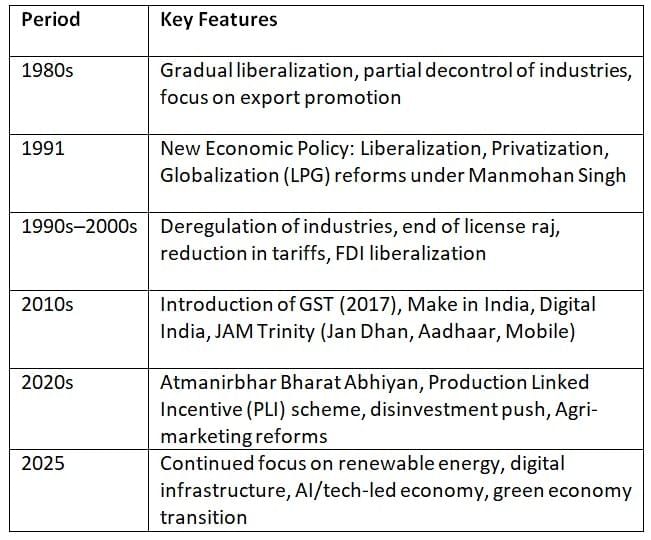UPSC Exam > UPSC Notes > Indian Economy for UPSC CSE > Cheat Sheet: Evolution of Indian Economy
Cheat Sheet: Evolution of Indian Economy | Indian Economy for UPSC CSE PDF Download
| Table of contents |

|
| Pre-Independence Economy |

|
| Post-Independence Economy |

|
| Prime Moving Force: Agriculture vs. Industry |

|
| Planned and Mixed Economy |

|
| Economic Reforms Since Independence |

|
Pre-Independence Economy
- India had a self-sufficient village economy with strong handicrafts and agriculture.
- Colonial policies led to deindustrialization (decline of indigenous industries) and commercialization of agriculture.
- Drain of wealth theory by Dadabhai Naoroji highlighted how British policies extracted surplus from India.
- Indian economy became stagnant, agrarian, and highly dependent on British markets.
- No major industrial base was developed due to British emphasis on raw material export.
Post-Independence Economy
- Faced challenges like partition, refugee influx, food shortage, lack of infrastructure and industrial base.
- Adopted a planned development approach under the Planning Commission (1950).
- First Five-Year Plan (1951–56) focused on agriculture, irrigation, and land reforms.
- Second Plan (1956–61) followed the Mahalanobis model, emphasizing heavy industries.
- Public sector dominated the commanding heights of the economy.
Prime Moving Force: Agriculture vs. Industry
- In the early decades, agriculture was the focus due to food insecurity and rural employment.
- Green Revolution (1960s–70s) improved productivity, especially in wheat and rice, but remained regionally skewed.
- Industrialization gained pace under the second and third Five-Year Plans.
- By the 1980s, industry and services began contributing more to GDP, reducing agriculture's share in total output.
- However, agriculture still employs a majority of the population.
Planned and Mixed Economy
- India adopted a mixed economy model combining public and private sectors.
- The public sector was entrusted with infrastructure, heavy industries, and social sectors.
- Private sector operated in consumer goods, small-scale industries, and services.
- Industrial Policy Resolution (1956) reinforced this approach, giving the state a dominant role.
- Emphasis was on import substitution, license-permit raj, and central planning.
Economic Reforms Since Independence

The document Cheat Sheet: Evolution of Indian Economy | Indian Economy for UPSC CSE is a part of the UPSC Course Indian Economy for UPSC CSE.
All you need of UPSC at this link: UPSC
|
108 videos|431 docs|128 tests
|
FAQs on Cheat Sheet: Evolution of Indian Economy - Indian Economy for UPSC CSE
| 1. What were the main characteristics of the Indian economy before independence? |  |
Ans. The pre-independence Indian economy was primarily agrarian, with agriculture being the mainstay for the majority of the population. The economy was characterized by a lack of industrial development, limited infrastructure, and high levels of poverty and unemployment. The British colonial policies exploited Indian resources, focusing on raw material extraction for British industries while neglecting local economic growth.
| 2. How did the focus shift from agriculture to industry in the post-independence Indian economy? |  |
Ans. Post-independence, India aimed to build a self-reliant economy, and the focus shifted towards industrialization. The government implemented policies to promote industries, including the establishment of public sector enterprises, encouraging private investment, and fostering a mixed economy. This shift was aimed at reducing dependency on agriculture and enhancing economic growth through industrial development.
| 3. What is meant by a Planned and Mixed Economy in the context of India? |  |
Ans. A Planned Economy refers to an economic system where the government makes all decisions regarding production and distribution of goods and services. In contrast, a Mixed Economy combines elements of both capitalism and socialism, allowing both private and public sectors to coexist. India adopted a mixed economy model post-independence, aiming to balance economic growth with social equity.
| 4. What have been the significant economic reforms in India since independence? |  |
Ans. Significant economic reforms in India since independence include the nationalization of banks and key industries, the Green Revolution to boost agricultural productivity, and the liberalization of the economy in the 1990s. These reforms aimed to enhance economic efficiency, attract foreign investment, and integrate India into the global economy, moving towards a more market-oriented approach.
| 5. How did economic reforms impact India's growth trajectory? |  |
Ans. Economic reforms transformed India's growth trajectory by fostering a rapid increase in GDP, enhancing industrial output, and improving the standard of living for many citizens. The liberalization policies led to increased foreign investment, technological advancement, and a more competitive market, contributing to significant economic growth and development in various sectors.
Related Searches















